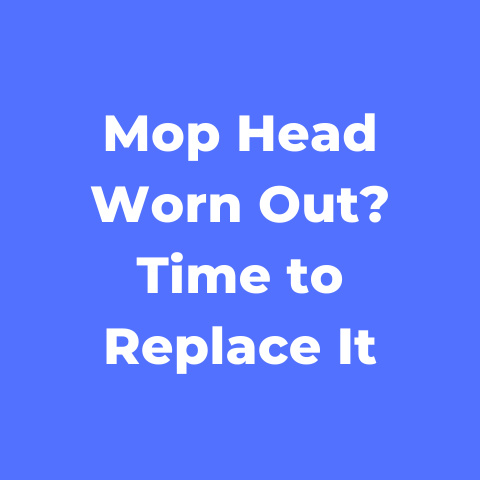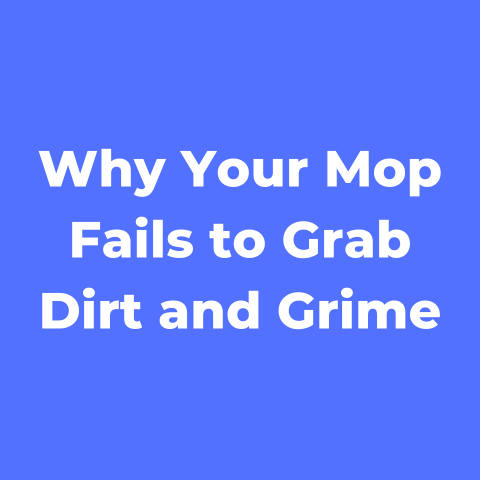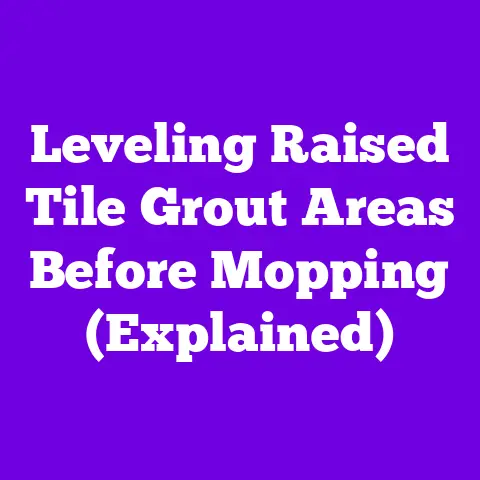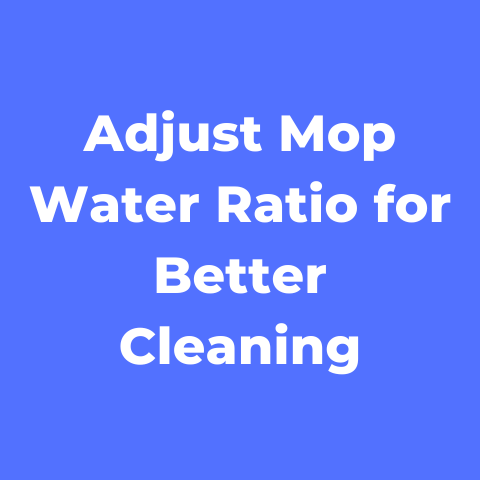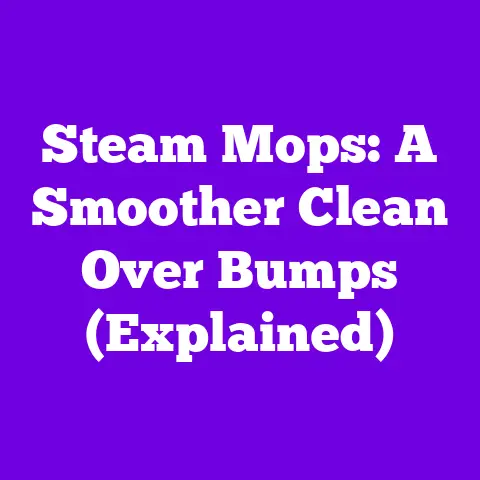Mop Too Wet? Learn This Simple Fix
Keeping floors clean is an important part of maintaining a healthy home. However, using an overly wet mop can leave floors dirty and create potential safety hazards. Luckily, there are a few simple fixes to easily wring out excess water from your mop to clean floors properly.
Why Proper Moisture Levels Matter
Mopping with excess water fails to trap dirt, spreads grime around, leaves messy puddles, and creates slippery surfaces that can lead to falls. On the other hand, using too little moisture leaves floors dirty and streaky.
Finding the ideal level of dampness for your mop ensures efficient dirt and bacteria removal without unwanted side effects. This comprehensive guide teaches you to quickly gauge appropriate moisture levels with easy tests. Follow our troubleshooting tips to master mop moisture regulation for sparkling clean and safe floors.
Common Causes of Overly Wet Mops
Several factors can result in a far too saturated mop that causes more harm than good:
Not Wringing Out The Mop Well
Simply failing to wring out excess liquid before mopping floors is one of the most common reasons behind an overly dripping mop. Taking the time to thoroughly wring out the mop head ensures much better absorbency for dirt trapping.
Using Too Much Cleaning Solution
Adding too much floor cleaner or water to your bucket mixes also leads to an extremely wet mop that gets floors dirtier despite your best cleaning intentions. Stick within recommended preparation ratios.
Mopping Floors That Are Already Wet
Trying to mop an already damp floor makes moisture regulation nearly impossible. Soak up excess standing water first before attempting to mop again.
Using The Wrong Mop For The Job
Some mop materials and designs inherently retain more water than others. Match your mop type and size appropriately to your floor area and mess level.
Not Letting Floors Fully Dry Between Mops
Back-to-back mopping of floors that haven’t completely dried allows water to accumulate to excessive sloshing levels. Take breaks between mops.
Solutions For Dealing With An Overly Wet Mop
If you’ve realized mid-mop that your floors are ending up too drenched, don’t panic. There are easy ways to rectify the situation quickly:
1. Wring It Out Better
Simply wringing out a mop multiple times with firm force and proper wringing technique makes a dramatic difference. Don’t be shy about applying elbow grease here. The more thoroughly you manually remove excess liquid, the more floor grime your mop will pick up.
2. Use Thick Paper Towels
For quick moisture reduction, press paper towels against your strands. The ultra-absorbent layers rapidly soak up dampness for temporary added mopping power until a full wash. Just don’t expect this to be as effective as full manual wringing.
3. Switch Out The Head
Having spare clean mop heads on hand gives the flexibility to do a quick swap when one gets too dripping mid-clean. Use the backup to finish the job then return to fully clean and dry the saturated original.
4. Let It Dry Out Further
Sometimes you simply need to give the mop a breather. Set aside the sopping mop for 5-10 minutes (turning it over so both sides air out). This allows some additional water to evaporate before trying again.
5. Use Less Solution Next Time
The best long term fix is adjusting the floor cleaner to water ratio in your bucket for less initial moisture. This prevents oversaturated mopping from the start – saving future clean up time and mess.
DIY Solutions For Building A Better Mop Wringer
Manually wringing out a mop by hand can only remove so much liquid. Investing in or making your own mop drying tool equips you to eliminate far more water.
Buying A Spin Mop Bucket
Pricier but highly effective spin mop bucket systems use centrifugal force to force out significantly more liquid than wrists alone can manage. Models with useful foot pedals make wringing a hands-free breeze.
Attaching A Rolling Wringer
Affordable add-on mop wringers with hand cranks offer commercial-style water removal without the spin components. Rolling the mop head through the presses pilots liquid out. These clip right onto normal mop handles.
Creating Manual Press Wringers
With some simple hardware store items like bolts and boards, you can construct DIY mop drying racks for removing water. Securely layering materials to tighten around mop strands when compressed pushes out plenty of moisture.
Hanging It Vertically
For a no-cost wringing method, tightly hang the mop upside down from an elevated rod or railing. Gravity draws excess water out the bottom as it air dries, with no mechanical intervention needed. Just be sure your hanging area allows for the considerable dripping.
Mop Moisture Quick Checks
Never guess about the dampness level of your mop again. Use these fast moisture meters to precisely gauge how wet your mop strands are before they touch floors:
Visual Checks
Simply eyeball the mop itself first. If streams of water are freely running out, it’s too wet. If zero dripping is happening, it’s likely too dry. When ready for use, a just-wrung mop should be saturated but not lose free droplets.
Gravity Test
After wringing a mop, give it one good forceful shake and watch for falling moisture. A couple small splatters are fine, but heavy raining drops indicate oversaturation requiring more wringing.
Paper Towel Test
For a similar shake test but with an absorbent indicator, lay paper towels beneath the shaken mop. If they remain fully dry, the mop may be under-wetted. Full towel soaking conveys overwetting. Light dampness shows ideal moisture levels.
Floor Touch Test
The ultimate way to know if a mop’s moisture level is correct is seeing its floor contact results. Gently lower the pre-wrung mop onto the floor in a small test area. If excess liquid transfers or puddling remains, wring further. If dirt residue is left behind, re-wet.
Preventing Excessively Wet Mops In The Future
Along with properly gauging moisture during active moping, utilize these proactive tactics to avoid overly saturated mops altogether:
Wring Thoroughly After Use
Don’t let mops sit wet after finishing. Give a final power wringing then allow to fully air dry upright to prevent musty residual smells and premature breakdown of strands.
Consider Synthetic Options
Bathroom and dust mops made with microfiber, nylon, polyester blends inherently retain less moisture than classic cotton strings. The right fibers can enhance drying potential.
Size Down For Small Spaces
Using an oversized mop on tiny floors adds unnecessary moisture. Opt for compact mop heads for better liquid-to-floor ratios on confined areas.
Use Mopping Direction Strategically
When mopping, work sections side-to-side rather than up-and-back. This contains excess liquid at the leading mop edge rather than trailing it out behind where you already cleaned.
Apply Correct Cleaning Solution Ratios
Too much floor cleaner or water premixed into mop buckets causes unnecessarily saturated mop heads. Carefully follow label dilution instructions for ideal wetness factors.
Let Floors Dry Before Re-Mopping
Floors need complete drying time between mops to avoid moisture build-up. Sticky residues wearing down mops also necessitates fuller drying.
FAQs: Troubleshooting Wet Mop Issues
Still struggling with overly sopping mops? Check out answers to these frequently asked moisture regulation questions:
How can I tell if my floors are too wet when mopping?
Floors that remain glossy, develop pooling puddles or show literal dirty footprints are clear signs of over-wetting during mopping. Shiny dry floors are the goal.
Do certain floors or spills require wetter mops?
Yes – extra messy floors like mudrooms and bathrooms often need added moisture, as does mopping up large liquid spills. But stick to product directions and promptly dry floors after.
Should I buy special equipment to remove mop moisture?
It depends on your mopping frequency and floor type. Occasional moppers can rely on elbow grease and gravity. Those cleaning large areas or certain delicate floors benefit from spin mops or wringers.
Can I use paper towels instead of mop wringing?
In a pinch, paper towels can soak up some excess mop moisture mid-job. But they lack the pressure and absorbency needed to properly prep a mop. Proper manual/mechanical wringing works best.
What homemade solutions actually help excessively wet mops?
Improvised mop drying solutions made from hardware store parts like handmade rolling wringers, vertical hanging rods, and DIY mop press racks provide genuine excess water removal similar to commercial models.
Is it okay to use a wet mop on laminate floors?
It’s fine to damp mop laminate floors as long as you avoid truly wetting them. Stick to slightly moist microfiber mops, immediately soak up drips, and thoroughly wring mops to prevent planks swelling over time.
In Closing
Learning to identify and resolve oversaturated mops doesn’t need to be an overly tough task. With the right moisture evaluation techniques, wringing equipment, floor drying knowledge and preventative habits, you can master mop moisture regulation.
Implement our recommended testing tricks and equipment upgrades for optimizing floors cleans without the hassles of excess mop moisture going forward. Check out our additional deep dive articles for handling other common mopping mistakes and cleaning challenges around your home.
What did you think of these fixes for extra wet mops? Do you have any other useful solutions to recommend? Let us know in the comments!

